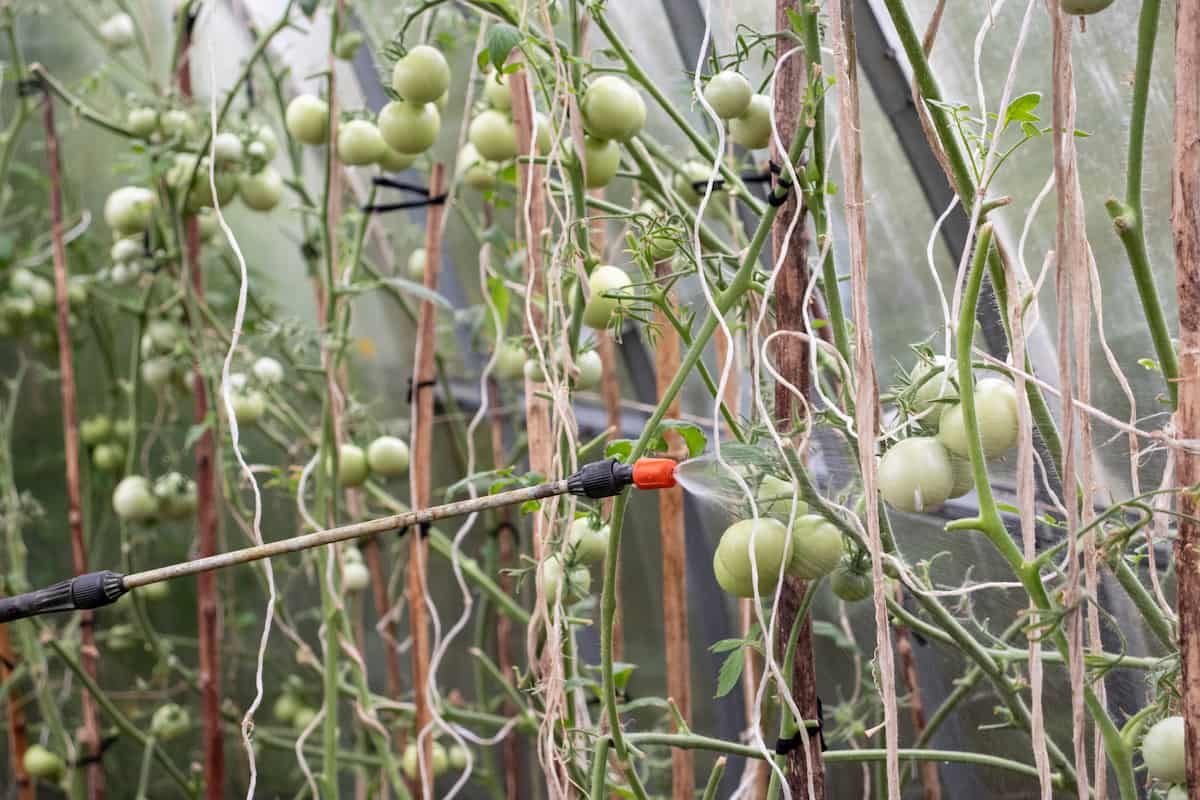Serpentine Leafminer is a small black and yellow fly that can infest tomato plants. The two commonly known species are Liriomyza sativae and Liriomyza trifolii, and their appearance can differentiate. The larvae of the two species can damage tomato leaves by feeding within the leaf tissue, creating serpentine mines. The mines can cause the leaves to become distorted and reduce the plant’s photosynthetic ability, resulting in yield loss.

Serpentine Leaf Miner management in Tomato
The life cycle of Serpentine Leaf Miner
The Serpentine Leafminer fly has a life cycle of up to 21 days. The adult fly lays its eggs in the leaf epidermis of host plants. The hatching 0f eggs within four days, and the larvae are yellow or green, going through three instars before pupating—the transformation of the pupa into an adult fly, a gray insect with black and yellow spots.
Factors favoring population increase in Serpentine Leaf Miner in the field
- Warm weather conditions are favorable for the multiplication of Serpentine Leafminer flies.
- The higher temperatures and humidity levels can lead to faster development and increased population levels of the insects.
Identification of Serpentine Leaf Miner in Tomato field
Serpentine Leafminer can be identified in a tomato field by its different stages of development.
- Eggs: The eggs are small and orange-yellow. They hatch within four days.
- Larva: The apodous maggot feeds on the chlorophyll, mining between the epidermal layers. When fully grown, the larva measures 3 mm in length. The larval stage lasts about seven days.
- Pupa: Pupation occurs in the soil or on the leaves and takes place inside a thin, loose mesh of silken cocoon. The pupal stage lasts about seven days.
- Adult: The adult is a pale yellowish fly that measures 1.5 mm in length. The female fly punctures the upper surface of the leaf to lay eggs singly. The total life cycle takes about three weeks.
Damage symptoms of Serpentine Leaf Miner in Tomato field
- Leaves with serpentine mines: The larvae create slender, white, winding trails on the leaves as they feed.
- Drying and dropping of leaves: In severe cases, the leaves may become heavily mined and have large whitish blotches. This can cause the leaves to drop prematurely, resulting in defoliation.
- Reduced yield and fruit size: If the infestation occurs early in the fruiting period, it can reduce the yield and size of the fruit, as well as expose it to sunburn.
- High numbers: Leafminers are typically a pest of late summer tomatoes and can reach high numbers. Pole tomatoes, which have a long fruiting period, are more vulnerable than other tomato crops.
In case you missed it: Powdery Mildew Disease Management in Wheat: Symptoms, Treatment, Chemical, Biological, Natural, and Organic Control

C.ultural control of Serpentine Leaf Miner
- Rotating crops: If a series of tomato crops are planted in the same area, removing old plantings immediately after the last harvest can help reduce early infestations in a new crop.
- Planting less susceptible varieties: Planting tomato cultivars with curled leaves that are less susceptible to leafminer infestation can help reduce damage caused by the insect.
- Avoid planting in infested areas: Do not plant vegetables in areas with previous leafminer infestations.
- Removing old plants: Always remove old tomato plants end of the season to prevent the buildup of leafminer populations.
Biological control of Serpentine Leaf Miner
- Biological control is to attract predatory insects like lacewings and ladybugs, which feed on leafminer larvae.
- By planting flowers like dill, coriander, or fennel near your tomato plants, you can create a habitat for these beneficial insects.
- Additionally, avoiding broad-spectrum insecticides can help preserve populations of parasitic wasps and other beneficial insects.
- Neem seed kernel extract is one chemical control option for serpentine leaf miners in tomatoes. The application of a 5% solution as a spray can help to reduce the population of the insect.
Chemical control of Serpentine Leaf Miner
- It is important to take an integrated approach to manage pests by combining preventive measures with biological treatments.
- Using a single pesticide may not effectively control the pest due to its cryptic nature, high reproductive capacity, and potential for resistance development.
- To reduce the risk of resistance, it is recommended to rotate multiple insecticides, such as indoxacarb, abamectin, azadirachtin, and fenoxycarbe+lufenuron.
In case you missed it: Fruit Borer (Helicoverpa) Management in Cotton: Symptoms, Treatment, Chemical, Biological, Natural, and Organic Control

Organic/natural control of Serpentine Leaf Miner
- Utilize predatory insects such as Trichogramma pretiosum, Nesidiocoris tenuis, and Macrolophus pygmaeus
- Apply fungal agents such as Metarhizium anisopliae and Beauveria bassiana to attack the eggs, larvae, and adults of the pest
- Use Neem seed extracts or insecticides containing Bacillus thuringiensis or Spinosad.
- Encourage beneficial insects and predators: Encourage the presence of predators like ladybugs, lacewings, and parasitic wasps, which feed on leaf miners.
- Use companion planting: Planting herbs like basil, marigold, or chrysanthemum around the affected plants can deter leaf miners and other pests.
- Apply Neem oil: Neem oil is an effective natural insecticide that can be used to control leaf miners and other pests.
- Handpicking: Remove infested leaves and destroy them to help reduce the population of leaf miners.
- Maintain proper plant health: Make sure the plants have enough water and nutrients and avoid overcrowding to maintain their overall health and ability to fight off pests.
- Use floating row covers: Covering the affected plants with floating row covers can prevent adult leaf miners from laying eggs on the leaves.
Preventive measures for control of Serpentine Leaf Miner
- Make use of pest-free transplants.
- To catch the adults, monitor the field with sticky or pheromone traps.
- Take damaged plants and plant parts and destroy them.
- Plow the soil and cover it with plastic mulch or perform solarization to control alternative host plants in and around the field.
- After harvest, remove and destroy infested plants. Wait at least six weeks before planting the next crop to prevent carryover.
- Implement extensive crop rotation.
Conclusion
In conclusion, Serpentine Leaf Miner is a significant problem for vegetable growers, particularly in tomato production areas. To effectively control this pest, an integrated approach combining cultural, biological, and physical methods should be implemented to keep its population below the damage threshold. This will help reduce the economic impact of this pest and ensure a healthy and sustainable crop yield.
- Beneficial Insects in Pest Management
- Natural Solutions for Pest Control in Flower Gardens
- Types of Fungicides Used in Agriculture
- Common Issues in the Fruit Development Stage of Pomegranate Farming
- Fruit Development Issues in Papaya: Easy Solutions and Treatment
- Soil-Borne Diseases and How to Protect Your Plants
- Practices to Prevent Disease Spread in the Garden
- From Wilted to Thriving: How to Treat Root Rot Naturally in Houseplants
- Natural Remedies to Cure Brown Spots on Fig Tree Leaves